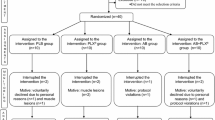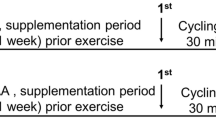Abstract
Reduced glutathione (GSH) plays a central role in maintaining an effective synergism between various physiological and exogenous antioxidants. We tested the effects of GSH andN-acetylcysteine (NAC, a pro-GSH clinical drug), intraperitoneal (i.p.) supplementation and GSH deficiency on exercise-induced leucocyte margination and neutrophil oxidative burst activity. GSH, NAC (1g · kg−1) or placebo saline was i.p. injected (one or eight times) to male rats (n ⩾ seven per group). The GSH-deficient rats were prepared by i.p. injections ofl-buthionine-[SR]-sulphoximine (BSO, 6 mmol · 1−1 · kg−1) twice daily for 4 days. Exercised animals were subjected to treadmill run to exhaustion. Exhausting treadmill exercise significantly decreased peripheral blood leucocyte count in the controls (P < 0.001). Such exercise-associated leucocyte margination was prevented by GSH supplementation. Peripheral blood neutrophil counts were significantly higher (P < 0.02) in the GSH-supplemented groups compared to the placebo control groups. Exercise-induced increase in peripheral blood neutrophil oxidative burst activity as measured by luminol-enhanced chemiluminescence per volume of blood tended to be higher in the GSH-supplemented group (P < 0.10), and lower in the GSH-deficient rats (P < 0.02). In these experiments, for the first time we have shown that GSH supplementation can induce neutrophil mobilization and decrease exercise-induced leucocyte margination, and that exogenous and endogenous GSH can regulate exercise-induced stimulation of the neutrophil oxidative burst.
Similar content being viewed by others
References
Allen RC, Mills EL, McNit TR, Quite PG (1981) Role of myeloperoxidase and bacterial metabolism in chemiluminescence of granulocytes from patients with cronic granulomatous disease. J Infect Dis 144:344–348
Baehner RL, Boxer LA, Allen JM, Davis J (1977) Autooxidation as a basis for altered function by polymorphonuclear leukocytes. Blood 50:327–335
Besner GE, Glick PL, Karp MP, Wang WC, Lobe TE, White CR, Cooney DR (1992) Recombinant human granulocyte colonystimulating factor promotes wound healing in a patient with congenital neutropenia. J Pediatr Surg 27:288–291
Bridges RB (1985) Protective action of thiols on neutrophil function. Bur J Respir Dis 66:S139, 40-48
Cannon JG, Blumberg JB (1994) Acute phase immune response in exercise. In: Sen CK, Packer L, Hänninen O (eds) Exercise and oxygen toxicity. Elsevier Amsterdam, pp 447–462
Ciriolo MR, Paci M, Sette M, Martino A De, Bozzi A, Rotilio G (1993) Transduction of reducing power across the plasma membrane by reduced glutathione. A1H-NMR spin-echo study of intact human erythrocytes. Eur J Biochem 215:711–718
Elferink JG, de-Koster BM (1991) Glutathione-induced enhancement of neutrophil locomotion. Immunobiology 184:25–36
Fearon DT, Collins LA (1983) Increased expression of C3b receptors on polymorphonuclear leukocytes induced by chemotactic factors and by purification procedures. J Immunol 130:370–375
Ferry A, Picard F, Duvallet A, Weill B, Rieu M (1990) Changes in blood leukocyte populations induced by acute maximal and chronic submaximal exercise. Eur J Appl Physiol 59:435–442
Galun E, Burstein R, Assia E, Tur-Kaspa I, Rosenblum J, Epstein Y (1987) Changes of white blood cell count during prolonged exercise. Int J Sports Med 8:253–255
Glasser L, Fiederlein RL (1990) The effect of various cell separation procedures on assays of neutrophil function. Am J Clin Pathol 93:662–669
Hack V, Strobel G, Rau J-P, Weicker H (1992) The effect of maximal exercise on the activity of neutrophil granulocytes in highly trained athletes in a moderate training period. Eur J Appl Physiol 65:520–524
Komatsu H, Koo A, Ghadishah E, Zeng H, Kuhlenkamp JF, Inoue M, Guth PH, Kaplowitz N (1992) Neutrophil accumulation in ischemic reperfused rat liver: evidence for a role for superoxide free radicals. Am J Physiol 262:G669-G676
Leff JA, Wilke CP, Hybertson BM, Shanley PF, Beehler CJ, Repine JE (1993) Postinsult treatment withN-acetyl-l-cysteine decreases IL-1-induced neutrophil influx and lung leak in rats. Am J Physiol 265:L501-L506
Lilius E-M, Marnila P (1992) Photon emission of phagocytes in relation to stress and disease. Experientia 48:1082–1091
McCord JM, Roy RS (1982) The pathophysiology of superoxide: roles in inflammation and ischemia. Can J Physiol Pharmacol 60:1346–1352
Meister A (1991) Glutathione deficiency produced by inhibition of its synthesis, and its reversal; applications in research and therapy. Pharmacol Ther 51:155–194
Michna H (1989) Ultrastructural features of skeletal muscle in mice after physical exercise: its relation to the pathogenesis of leucocyte invasion. Acta Anat 134:276–282
Neuschwander BA, Roll FJ (1990) Chemothactic activity for human PMN generated during ethanol metabolism by rat hepatocytes: role of glutathione and glutathione peroxidase. Biochem Biophys Res Commun 167:1170–1176
NIH (1985) Guide for the care and use of laboratory animals. NIH Publication no. 85-23 revised. National Institute of Health, Washington, DC
Peters AM, Allsop P, Stuttle AWJ, Arnot RN, William MG, Hall GM (1992) Granulocyte margination in the human lung and its response to strenuous exercise. Clin Sci 82:237–244
Petrone WF, English DK, Wong K, McCord JM (1980) Free radicals and inflammation: superoxide-dependent activation of a neutrophil chemotactic factor in plasma. Proc Natl Acad Sci USA 77:1159–1163
Scott RB, Matin S, Hamilton SC (1990) Glutathione, glutathione S-transferase, and transmembrane transport of glutathione conjugate in human neutrophil leukocytes. J Lab Clin Med 116:674–680
Sen CK (1995) Oxidants and antioxidants in exercise. J Appl Physiol 79:675–686
Sen CK, Hänninen O (1994) Physiological antioxidants. In: Sen CK, Packer L, Hänninen O (eds) Exercise and oxygen toxicity. Elsevier, Amsterdam, pp 89–126
Sen CK, Atalay M, Hänninen O (1994a) Exercise induced oxidative stress: glutathione supplementation and deficiency. J Appl Physiol 77:2177–2187
Sen CK, Rankinen T, Väisänen S, Rauramaa R (1994b) Oxidative stress- after human exercise: effect ofN-acetylcysteine supplementation. J Appl Physiol 76:2570–2577
Shingu M, Nobunaga M (1984) Chemotactic activity generated in human serum from the fifth component of complement by hydrogen peroxide. Am J Pathol 117:201–206
Smith JA, Telford RD, Mason IB, Weidemann MJ (1990) Exercise, training and neutrophil microbicidal activity. Int J Sports Med 11:179–187
Smith JK, Grisham MB, Granger DN, Korthuis RJ (1989) Free radical defense mechanisms and neutrophil infiltration in postischemic skeletal muscle. Am J Physiol 256:H789-H793
Ward PA, Michigan AA (1991) Mechanisms of endothelial cell killing by H2O2 or products of activated neutrophils Am J Med 91:89S-94S
Weiss SJ (1989) Tissue destruction by neutrophils. N Engl J Med 320:365–3761
Author information
Authors and Affiliations
Rights and permissions
About this article
Cite this article
Atalay, M., Marnila, P., Lilius, EM. et al. Glutathione-dependent modulation of exhausting exercise-induced changes in neutrophil function of rats. Europ. J. Appl. Physiol. 74, 342–347 (1996). https://doi.org/10.1007/BF02226931
Accepted:
Issue Date:
DOI: https://doi.org/10.1007/BF02226931




